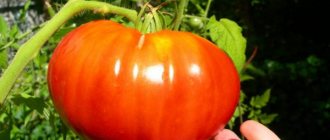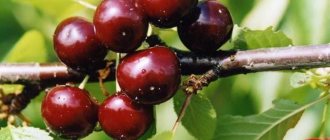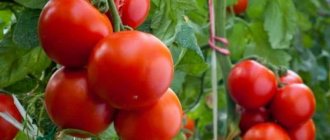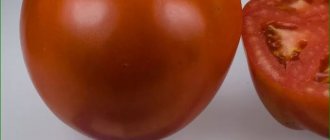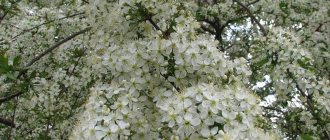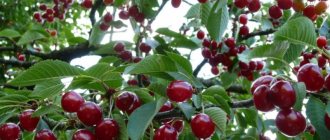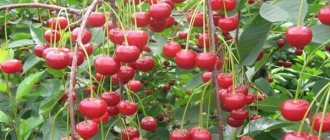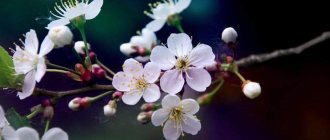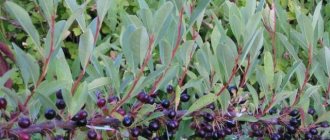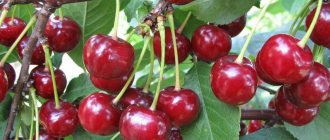Description of culture
Features of the Turgenevskaya cherry tree:
- average vigor;
- tree height from 3 to 3.5 m;
- crown of medium density, in the shape of an inverted pyramid;
- straight brown branches of medium length;
- buds 50 mm long, cone-shaped;
- the bark of the trunk is brown in color with a bluish tint;
- leaves are dark green, narrow, oval, with a sharp tip;
- the leaf plate has a boat shape and a glossy surface.
The inflorescences consist of 4 flowers. The petals are white and fit tightly to each other. Flower size is about 2.4 cm.
Characteristics of Turgenevka cherry fruits:
- average weight 4.5 g;
- size 2x2 cm;
- broad-heart shape;
- ripe fruits have a rich burgundy skin;
- dense and juicy pulp;
- sweet and sour taste:
- cream seeds weighing 0.4 g;
- stalks about 5 cm long;
- the seeds are well separated from the pulp;
- tasting score – 3.7 points out of 5.
The Turgenevka variety is recommended for cultivation in the following regions:
- Central (Bryansk region);
- Central Black Earth (Belgorod, Kursk, Oryol, Voronezh, Lipetsk regions);
- Northern Caucasus (North Ossetia).
Photo of Turgenevka cherry tree:
Cherry Turgenevskaya: reviews about the variety
Marina, 40 years old, Saratov region : “I grow 2 Turgenevskaya cherry trees at my summer cottage. I have had a rich harvest from this for 4 years now. The branches bend from the weight of the berries. Pollinators are an important condition for a generous harvest. There are 3 varieties of cherries growing near Turgenevskaya, and they are pollinators for the Turgenevskaya cherry. Cherries are not afraid of winter and are not susceptible to diseases, but we process the trees consistently. The berries are large, dark, and have a pleasant aroma. We make jams and compotes from them. We also do freezing. One minus of Turgenevskaya cherries is that the fruits are slightly sour, especially when they are picked early.”
Alexander, 47 years old, Krasnodar region: “2 years ago I planted Turgenevskaya cherries at my dacha. That year I was very surprised. It's nice, of course. The variety produced a large harvest and large berries. The tree is of medium height and is immune to diseases. The berries are bright, almost black in color, and do not have symptoms of coccomycosis. Although the Turgenevskaya cherry variety pollinates itself, cherries and cherries are planted near it, which pollinate it. The tree blooms and produces so many fruits that it can be compared to garlands. The taste of Turgenevskaya cherries is sour, which means that the berries are used for twisting.”
Cherry Turgenevskaya: video about the variety
Characteristics
According to reviews from gardeners about the Turgenevka cherry, its resistance to drought, frost, diseases and pests deserves special attention.
Drought resistance, winter hardiness
Turgenevka cherries are characterized by average resistance to drought. In hot weather, it is recommended to water the trees, especially during the flowering period.
The Turgenevskaya variety has high winter hardiness. Trees tolerate temperatures as low as -35 °C.
Flower buds have average resistance to cold weather. The variety is susceptible to spring frosts and sudden temperature changes.
Pollination, flowering period and ripening time
Flowering occurs in the middle period (mid-May). The ripening period for Turgenevskaya cherries is early or mid-July.
The Turgenevka variety is partially self-fertile and is capable of producing crops without pollinators. To increase productivity, cherries or other cherry varieties with a similar flowering period are planted in close proximity to the tree.
The best pollinators of Turgenevka cherries are considered to be the varieties Lyubskaya, Favorit, Molodezhnaya, Griot Moskovsky, and Melitopol Joy. In the presence of pollinators, the shoots of the tree are covered with fruits and often bend to the ground under their weight.
Productivity, fruiting
Fruiting of the Turgenevka variety begins 4-5 years after planting. The life span of the tree is 20 years, after which the cherry tree needs to be replaced.
A young tree bears about 10-12 kg of fruit. The yield of mature cherries is about 20-25 kg.
After ripening, the fruits do not fall off and remain hanging on the branches. Under the sun, their flesh wilts and becomes sweeter in taste.
Area of application of berries
Turgenevka cherries are suitable for home canning: making juices, compotes, jams, tinctures, syrups, fruit drinks. Due to the sour taste, the fruits are rarely used fresh.
Resistance to diseases and pests
The Turgenevka variety is characterized by average resistance to diseases and pests. Most often, trees show signs of moniliosis and cocomycosis. Caring for the variety involves preventive spraying.
Advantages and disadvantages
Advantages of the Turgenevka variety:
- high and stable yield;
- large fruits;
- good winter hardiness;
- transportability of fruits.
Before planting the Turgenevka variety, take into account its main disadvantages:
- sour taste of fruits;
- dependence of yield on pollinator;
- early pregnancy is below average.
Features of cultivation and subtleties of care
Caring for the Turgenevka cherry variety is a system of simple, even obvious, actions that any amateur gardener can and knows how to perform.
Caring for Turgenevka cherries is very simple and does not require special knowledge or extensive experience.
- Firstly, it is timely watering, preferably with warm water at the rate of 2-3 buckets per bush. Like any tree, Turgenevka needs moisture-recharging autumn watering several times greater in volume than usual. Except for the first autumn. The soil should not become waterlogged, so pour water carefully; if there is excess in the form of stagnation, drain it through a small ditch.
- Secondly, for the winter, cherries need to be protected from freezing for the first three years after planting. In addition, it is better to add mulch again before winter: peat or rotted sawdust, you can use fallen pine needles. Do not mulch with old leaves and plant debris, as they may contain pathogenic bacteria or parasite larvae. In contrast, pine needles have bactericidal properties and are therefore safe as mulch.
- Mineral fertilizers are applied to the roller (around the trunk) surrounding the tree once in the spring season every year and organic fertilizers once every 2–3 years. From minerals, you can choose a balanced complex for fruit plants, for example Emerald, Bloom Complex or Ryazanochka. The latter is good because it does not contain chlorine and is ideal for berry crops. In the form of organic fertilizers, you can use mullein and an infusion of chicken manure. But remember that organic matter takes more than one season to decompose; there is no need to over-water the bush. A bucket of mullein or manure diluted with water is enough (3 parts water to 1 part organic matter). In addition, excess can negatively affect the taste of the fruit.
- Pruning is done on a tree that has overwintered; of course, the spring months are excellent for this. At the end of March or April, remove dry or damaged branches. And also those parts, them evenly. Leave only those branches that are higher than half a meter from the ground. Remove those that protrude too much, that is, long ones (more than 0.5 meters).
- If the cherry is no longer young and bears fruit for more than one year, you need to cut off the thick side stems. This way you stimulate the development and growth of new shoots.
A growing cherry tree needs to be helped to “develop” the territory. That is, it is necessary to constantly loosen and expand the tree trunk circle as the cherry grows.
Recent Entries
5 working ways to use tar in the garden 7 indoor plants that help you get married even in adulthood Indoor plants that can bloom in trouble
As you grow, you need to gradually expand the earthen circle near the trunk in order to carefully water, fertilize and thereby provide the roots with everything they need.
How and when to prune cherries
Landing Features
Planting of Turgenevskaya cherries is carried out within a certain time frame. The fruiting of the variety depends on the correct choice of place for cultivation.
Recommended timing
Planting work is carried out in the fall in September or October, when the leaves fall. It is important to plant the cherry tree before the weather gets cold so that the seedling has time to take root.
When planting in spring, work begins after the soil has warmed up, but before the buds open. The best time for planting is the second ten days of April.
Choosing a suitable location
Cherry prefers places well lit by the sun. The tree is planted on a hill or on a flat area. It is not recommended to place cherries in places with high groundwater or in lowlands where moisture accumulates.
The culture grows well in drained soil: loam or sandstone. Acidic soil is not suitable for growing cherries. Lime or dolomite flour, which is embedded to the depth of a shovel bayonet, will help reduce acidity. After a week, the soil is fertilized with compost.
What crops can and cannot be planted next to cherries?
Turgenevka cherry gets along well with other shrubs. Other varieties of cherries, grapes, rowan, hawthorn, sweet cherry, and honeysuckle are planted next to the tree at a distance of 2 m. The exceptions are raspberries, currants and sea buckthorn.
Advice! You can plant elderberry next to the crop, the smell of which repels aphids.
It is better to remove apple, pear, apricot and other fruit crops 5-6 m from the cherry tree. Their crown creates shade, and the roots absorb many useful substances.
Beds with tomatoes, peppers and other nightshades should not be set up next to the plantings. You should also remove the Turgenevka variety from birch, linden, maple and oak.
Selection and preparation of planting material
For planting, choose a two-year-old seedling of the Turgenevka variety with a height of up to 60 cm and a trunk diameter of 2 cm. There should be no signs of rotting, cracks or other damage on the roots and shoots.
After purchase, the roots of the seedling are kept in clean water for 3-4 hours. You can add the stimulant Cornerost to the water.
Landing algorithm
The order of planting Turgenevka cherries:
- At the selected location, dig a hole 70 cm in size and 50 cm deep.
- The pit is left for 3-4 weeks to shrink. If cherries are planted in the spring, you can prepare the hole in late autumn.
- Add 1 kg of ash, 20 g of potassium sulfate and 30 g of superphosphate to the fertile soil.
- The soil mixture is poured into the hole, then the seedling is placed in it.
- The roots of the cherry are straightened and covered with earth.
- The soil is compacted well. The seedling is watered abundantly.
Reproduction
You can grow a new crop yourself. There will be several methods of reproduction.
Seed method
As planting material, you need to collect seeds from ripe berries, wash and dry them. Sowing in open ground is carried out in September or April; until this time they should be stored in a container with damp sand.
The seeds are sown in the soil, deepened by 3-4 cm, covered with a layer of peat and humus on top. Further care consists of regular watering and loosening the soil.
Grafting method
Cuttings are grafted onto wild cherry seedlings in the spring. The collected material for grafting is cut into several parts, each with at least 3-4 buds. The scion is secured into the split by the bark. Wrap the joint with film or rags.
Cuttings
Green cuttings are harvested in the first half of June, choosing shoots 25-30 cm long with several leaves. The top of the planting material is cut at a right angle, the bottom cut is made at an angle of 45 degrees.
Before planting, they are kept for 12 hours in a growth stimulator and rooted in neutral soil with a good level of aeration. Care involves maintaining a high level of humidity, so the cuttings should be sprayed regularly. As a rule, the first roots will appear within 20-40 days.
Subsequent care of the crop
Dry, weak, broken and frozen shoots are removed from Turgenevka cherries. Pruning is performed before or after the growing season.
To prepare for winter, the tree is watered abundantly in late autumn, after which the trunk is hilled up. The soil in the tree trunk circle is mulched with humus. To protect against rodents, spruce branches are tied to the trunk.
Advice! If there is heavy rainfall, the tree does not need watering. If there is a drought during the flowering period, it is recommended to moisten the soil every week.
Full feeding of Turgenevka cherries begins 3 years after planting. In early spring, the tree is watered with mullein infusion. During and after the flowering period, 50 g of superphosphate and potassium salt are incorporated into the soil.
Further care
Cherries will delight you with a stable harvest if you provide them with proper care.
After all planting measures have been taken, the tree requires comprehensive care: loosening, watering, pruning, fertilizing, as well as protection from diseases and pests.
Watering and weeding
Watering and weeding will help the tree develop well
During the growing season, you should regularly fight weeds and clear the tree trunk of them. You also need to moisten the cherries in a timely manner. Water is supplied to a hole 15–20 cm deep, dug along the projection of the crown.
Table: watering schedule
| Watering time | Water norm |
| In the last ten days of May | 50–60 l per 1 m2 of tree trunk area |
| At the end of June | |
| In the first half of autumn | 70 l per 1 m2 |
Fertilizer application
Fertilizers nourish the cherries and they will be able to form a tasty harvest.
A lack of nutrients can cause slower growth of shoots, as well as changes in the color of leaves, which become reddish or purple. Cherries, in addition to mineral elements, respond well to the application of compost. It is advisable to start preparing it in the fall; in this case, in the spring the fertilizer will be ready for use:
- a 15 cm thick layer of peat, 25 cm layer of weeds or tops, chicken droppings or dry cow manure are placed in the box;
- 250 g of potassium sulfate, 500 g of double superphosphate and ammonium nitrate and another layer of peat are scattered on top;
- After 2 months, the compost needs to be dug up and the box should be placed indoors.
Table: cherry feeding schedule
| Tree age | Deadlines for depositing | Composition and its norm |
| Second year | In early spring | 100 g of urea in the tree trunk area (added when digging) |
| Third year |
| |
| Fourth year | In August | 600 g of superphosphate and 100 g of potassium sulfate. |
| In October | 20 kg of compost. | |
| Fifth and sixth years | At the beginning of spring | 30 g ammophoska per 10 l. |
| Seventh year | in spring | 300 g urea. |
| in autumn |
|
In the future, mineral fertilizers are used every two years, and organic matter is added every four years (in this case, you must adhere to the norms that are applied in the seventh year).
Tree pruning
Cherry trees are pruned in spring and autumn.
The trunk at Turgenevka is formed at a height of 80 cm. All branches located below must be removed to allow the tree to set fruit on the strongest branches.
In the early spring of the second year, before the buds open, pruning is performed:
- The 5–6 strongest branches are left on the tree, extending from the trunk at an angle of 45°. It is advisable that they be arranged in three rows. The first tier should consist of three shoots, the second - of two, and the top - of one branch. Rows are formed at a distance of 50–60 cm.
- All excess shoots are cut to the level of the ring influx.
- Subsequently, the crown is thinned annually.
- Thickening, intertwining and inward growing branches must also be removed.
- If the length of annual shoots reaches 50 cm or more, they should be shortened above the side bud. Otherwise, pruning of branches should not be carried out, since new growths will not form on the tree. This will also lead to a decrease in yield.
When the size of annual growths does not exceed 15–20 cm, you need to begin rejuvenating the tree. Pruning is performed at the level of a side branch of four- or five-year-old wood.
At the age of 12–15 years, the cherry growths located at the ends of the shoots weaken, and new branches and bouquet branches also cease to form. Such a tree needs to be shortened more strongly. The branches are pruned at the level of seven-year-old wood.
Important! In the fall, they get rid of damaged, diseased and dry shoots.
Garden varnish will protect cut areas from infections
The cut areas must be treated with garden varnish . This will help protect the tree from infections, pests, and will also prevent the branches from drying out. You can purchase it ready-made or make it yourself.
To prepare the brew, you need:
- melt 6 parts paraffin, add 3 parts rosin;
- When the mixture boils, pour in 2 parts of sunflower oil and keep on low heat for another 10 minutes.
The composition is used after cooling. It should be stored in a tightly closed container, away from direct sunlight.
Video: pruning workshop
Preparing for winter
Since Turgenevka has good frost resistance, it is able to endure winter without shelter. In autumn, fallen leaves are removed around the tree and the soil is dug up to a depth of 15 cm. Work must be carried out in an area corresponding to the projection of the crown. Do not dig the soil deeper than the recommended level, as you may damage the roots . Then the trunk and the bases of the skeletal branches are treated with whitewash. But before whitewashing a tree, it is necessary to remove all dead bark down to living tissue. This can be done with a wire brush.
Diseases and pests, methods of control and prevention
The main diseases to which cherries are susceptible are given in the table:
| Disease | Symptoms | Control measures | Prevention |
| Moniliosis | Leaves, flowers and shoot tips dry out. Over time, gray growths appear on the bark. | Spraying with Bordeaux mixture or Cuprosan solution. |
|
| Cocomycosis | Distribution of brown spots on the leaves, under which a pinkish coating appears. | Spraying with Bordeaux mixture and copper sulfate solution. | |
| spotting | Brown or yellow spots on the leaves, drying out of the fruit pulp. | Spraying with a 1% solution of copper sulfate. |
The most dangerous cherry pests are listed in the table:
| Pest | Signs of defeat | Control measures | Prevention |
| Aphid | Leaves rolled into a tube. | Treatment with Fitoverm insecticide. |
|
| cherry fly | The larvae eat the pulp of the fruit, which rots and crumbles. | Spraying with Aktara or Iskra insecticides. | |
| codling moth | The larvae feed on the fruits, leading to crop loss. | Treatment of cherries with benzophosphate. |
Reviews
Anna, Saratov : I have 3 Turgenevka and Lyubskaya growing on my plot, the seedlings began to bear fruit only 5 years after planting. The variety is distinguished by its excellent winter hardiness; to prevent fungal diseases, I carry out preventive sprayings every season. The berries are quite large and beautiful; thanks to their sourness, they are ideal for compotes and baked goods.
Nikolai Stepanovich, Volzhsky : My cherries produce large harvests every year. It happens that the branches bend towards the ground due to the number of berries. I think that I chose the right pollinator – Coeval. It gets sick very rarely; regular cleaning of the garden before wintering practically eliminates the need for preventive treatments with store-bought chemicals.
Ekaterina Semyonovna, Goryachy Klyuch : I bought two seedlings and began to harvest small crops for the 3rd season. The trees are very promising, the berries taste like real cherries - with sourness.
Agricultural technology for growing Turgenevka cherries
It is better to plant young trees in a permanent place in the fall - about a month before the onset of cold weather. In this case, the seedlings will have time to take root and get stronger before the onset of winter.
In the spring, the time for planting Turgenevskaya cherries is after the soil has warmed up to 15 degrees Celsius, until the leaves begin to bloom.
Planting cherries - video
This cherry loves well-lit areas without drafts or cold winds.
. It is better to plant it on flat areas or a small hill. But lowlands and places where groundwater comes too close to the soil surface are contraindicated for Turgenevka cherries.
The best soils for this stone fruit tree are loams or sandstones with neutral or slightly alkaline acidity. Too acidic soil is improved with lime or dolomite flour.
Turgenevka cherry seedlings for planting are chosen to be two years old, with a healthy and strong root system and intact branches.
The diameter of the planting holes should be about 0.65 m and the depth - 0.5 m
. A drainage layer is laid at the bottom of the pits, then a nutrient substrate consisting of garden soil, ash, potassium salt and superphosphate. 1.5 buckets of water are added to each hole and the hole is left to settle for a month.
Then you can plant young trees of the Turgenevka variety. A peg is placed in the hole, a seedling is placed nearby and tied to a support. The roots need to be carefully spread over the entire hole, carefully covered with soil on top, compacted and 10-15 liters of water added under each tree.
Cherry planting scheme:
Harvesting and storage conditions
The berry ripening period is July 5-15. The fruit must be picked with the stalk. It is better to harvest in one go, since overripe cherries instantly fall off. The optimal time for this activity is the morning in dry weather conditions.
The harvest should be collected in a basket and sent for storage in a room with a temperature ranging from 0 to −1 ° C and an optimal humidity of 90-95%. Under such conditions, cherries are suitable for consumption for 15 days.
Attention! If you put the cherries in plastic bags and cover them tightly, you can increase the storage period to 1.5 months. For longer preservation, it is recommended to put bags of fruits in the freezer.
Area of application of berries
Turgenevka fruits are excellent both fresh and suitable for making compote, fruit juice, syrup, and jam. You can use them to make confitures, sauces, and add them as a filling to cakes and pies.
They are considered an indispensable ingredient in the production of homemade wine, liqueur, and medicinal tincture.
Use of healthy fruits
Advantages and disadvantages of the variety
The Turgenevka variety has held a strong position in the Russian market for quite a long time. All this is due to a number of advantages that this cherry variety has. Among the main ones:
- Excellent yield indicators.
- Large fruit.
- High frost resistance.
- The density of the shell, due to which the fruits are stored for a very long time and are not afraid of long-term transportation over long distances.
At the same time, it is worth noting a number of disadvantages that are inherent in this cherry variety:
- The fruits have a characteristic sourness.
- Flowers cannot withstand spring frosts, so if the spring turns out to be cold, the yield drops significantly.
- Despite all its unpretentiousness, cherries are still demanding on the type of soil.
Pollinators
Turgenevka itself is a partially self-fertile variety. However, to get a very good harvest, you still have to plant a pollinator nearby. The best pollinator varieties for Turgenevka:
- Griot Moscow.
- Lyubskaya.
- Melitopol joy.
- Youth.
- Favorite.
In addition, you should not forget about the old folk method: pollination with the help of bees. To do this, you need to dilute 1-2 tablespoons of honey in 3 liters of water. This solution is sprayed on cherries in sunny, windless weather. The aroma of honey will attract bees.

